|
|
|
Sort Order |
|
|
|
Items / Page
|
|
|
|
|
|
|
| Srl | Item |
| 1 |
ID:
157812


|
|
|
|
|
| Summary/Abstract |
Over the last two decades, China has experienced one of the most dramatic and sustained periods of economic growth in world history. China's use of economic statecraft provides an important venue in which to examine the role of unacknowledged ‘coercive diplomacy’ within the context of China's ‘peaceful rise discourse.’ In contrast to Western countries, which have overtly used sanctions and other forms of economic coercion, China has publicly denied any such policies while at the same time quietly pursuing them. China's denial of using coercive economic statecraft has muted the reactions of neighboring publics and government, but it cannot entirely forestall them. Without seriously undermining China's ‘peaceful-rising’ image, a more explicit statement from Beijing regarding its coercive economic measure could provide deterrence and assurance to China's neighbors in resolving the disputes. This article first surveys existing literature on economic statecraft focusing on the coercive aspects of such strategies. Second, it presents an in-depth case study on how China uses economic leverages over its neighbors in East Asia: North Korea, Japan, and the Philippines. Finally, it highlights the limits of China's economic statecraft within the constraints of China's ‘peaceful rise’ discourse. It concludes with implications for Asian politics and beyond.
|
|
|
|
|
|
|
|
|
|
|
|
|
|
|
|
| 2 |
ID:
094147
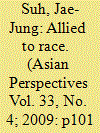

|
|
|
| 3 |
ID:
094149
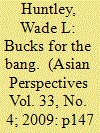

|
|
|
| 4 |
ID:
066171
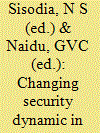

|
|
|
|
|
| Publication |
New Delhi, Institute for Defence Studies and Analyses, 2005.
|
| Description |
xxvi, 648p.
|
| Standard Number |
8186019529
|
|
|
|
|
|
|
|
|
|
|
|
Copies: C:2/I:0,R:0,Q:0
Circulation
| Accession# | Call# | Current Location | Status | Policy | Location |
| 050223 | 327.952/SIS 050223 | Main | On Shelf | General | |
| 050224 | 327.952/SIS 050224 | Main | Withdrawn | General | |
|
|
|
|
| 5 |
ID:
132883
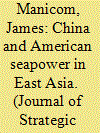

|
|
|
|
|
| Publication |
2014.
|
| Summary/Abstract |
Debates about the future of American seapower in East Asia turn on the argument that American seapower presents a risky and costly luxury that undercuts the cooperative potential of US-China relations. This article asks whether accommodation between China and the United States on the possession and exercise of American seapower in East Asia is possible. Accommodation on this front could significantly lower the risks of unintended escalation and in turn undermine arguments that favour an American retreat from East Asia. The article outlines how accommodation can be achieved on the exercise of American seapower in the region.
|
|
|
|
|
|
|
|
|
|
|
|
|
|
|
|
| 6 |
ID:
075780
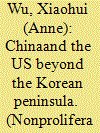

|
|
|
|
|
| Publication |
2006.
|
| Summary/Abstract |
China-U.S. cooperation over the most difficult security problem in Northeast Asia-the North Korean nuclear issue-in essence projects its bigger power game amid the tectonic shifts of Asian geopolitics. The nuclear issue affords a test case to gauge the future posture of China and the United States in East Asia and their partnership in that conflict-prone region. Approaches to resolving this issue must take into account the geopolitical realignment of Asia, Washington's reorientation of relations with its Asian allies, and China's rise as an influential regional player and the subsequent regional response. However, the long-standing mistrust between China and the United States is contributing to a lack of substantial progress in Korean nonproliferation efforts. The declared nuclear test by Pyongyang further put the denuclearization cooperation between China and the Unites States on the line. China-U.S. cooperation in denuclearizing Pyongyang may either produce lasting stability for the region or create ''collateral damage,'' with the North Korean issue paling in comparison.
|
|
|
|
|
|
|
|
|
|
|
|
|
|
|
|
| 7 |
ID:
128749
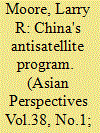

|
|
|
|
|
| Publication |
2014.
|
| Summary/Abstract |
I analyze the substance and goals of China's antisatellite program. Following China's 2007 antisatellite test that successfully destroyed one of its aging satellites, signs have emerged that China is continuing to research ways to exploit the heavy US reliance on space. This capability is most likely being developed as an "assassin's mace" to gain an advantage against a technologically superior enemy in the event of conflict. I propose a number of countermeasures to negate the threat to US space security
|
|
|
|
|
|
|
|
|
|
|
|
|
|
|
|
| 8 |
ID:
070703
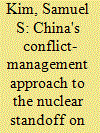

|
|
|
|
|
| Publication |
2006.
|
| Summary/Abstract |
This article provides an analysis and assessment of China's uncharacteristically proactive conflict-management (CM) diplomacy in the U.S.-North Korea (DPRK) nuclear standoff on the Korean peninsula from 2002 to 2005. In the first of four sections, the focus is on the global context and conditions that gave rise to CM studies as a new field of international relations research in the West. The second section argues that three proximate and underlying causes -- greater danger, greater stakes, and greater leverage --catapulted Beijing into the terra incognita of a CM leadership role. The third section examines the shift in China's role as well as the style and substance of this approach. The fourth section critically evaluates the possibilities and limitations of China's conflict-management diplomacy for the resolution of the U.S.-DPRK nuclear standoff. The conclusion is a brief assessment of future prospects for establishing a more peaceful and prosperous regional order in Northeast Asia either through the ongoing Six Party Talks or through some permanent Northeast Asian security regime coming out of the success or failure of the six-party process.
|
|
|
|
|
|
|
|
|
|
|
|
|
|
|
|
| 9 |
ID:
094145
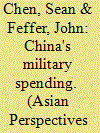

|
|
|
| 10 |
ID:
174730
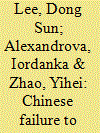

|
|
|
|
|
| Summary/Abstract |
This article explains China’s abortive attempt to stop North Korean nuclear development between 1993 and 2016. It attributes this failure to two international conditions. The first is geographical contiguity. As an adjacent great power, China had limited leverage over North Korea. Beijing’s threats of sanctions lacked credibility, as sanctions could trigger dangerous local instabilities. Its security inducements implied a risk of subordination, which Pyongyang was unwilling to accept. The second is the unipolar international system. Unipolarity curbed Beijing’s ability to protect Pyongyang from the United States, while simultaneously inducing China to pass the buck of restraining North Korea to the American unipole. This article corroborates these main arguments by drawing upon primary and secondary sources in Korean, Chinese, and English.
|
|
|
|
|
|
|
|
|
|
|
|
|
|
|
|
| 11 |
ID:
099605
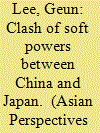

|
|
|
|
|
| Publication |
2010.
|
| Summary/Abstract |
This article argues that during the Six Party Talks on North Korea, China adroitly used its diplomacy to produce "soft-power synergy" while Japan became stuck with a "soft-power dilemma." Soft-power synergy refers to an outcome within which a success of an outward (foreign) soft-power strategy brings about simultaneous success of inward (domestic) soft-power strategy. On the other hand, soft-power dilemma denotes an outcome where a success of outward (or inward) soft-power strategy produces failure or negative influences in the inward (or outward) soft-power strategy. Borrowing from Robert Putnam's two-level game metaphor, this article tries to reveal the two-level dynamics of soft power by developing a refined conceptual framework of soft power and also by explicating a case study of Chinese and Japanese diplomacy at the Six Party Talks.
|
|
|
|
|
|
|
|
|
|
|
|
|
|
|
|
| 12 |
ID:
070705
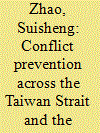

|
|
|
|
|
| Publication |
2006.
|
| Summary/Abstract |
China has developed a unique approach of conflict prevention characterized by liangshou celue -- literally, a "two hands" or a two-pronged strategy. It is a stick-and-carrot approach, involving an oscillating pattern of military coercion and peaceful offensive. After the fourth generation of Chinese leadership under Hu Jintao came to office, an Anti-Secession Law was passed by China's National People's Congress on March 14, 2005. Prescribing the conditions for military action against Taiwan, this law was described by some people in the West and Taiwan as a war authorization law, mainly driven by Chinese nationalism, to set a benchmark against nationalist pressure and show Chinese leaders' willingness to risk war across the Taiwan Strait at all cost. It thus is said to signify not only greater irrationality in China's policy toward Taiwan but also a change in the two-pronged conflict-prevention approach. Is Chinese nationalism in fact a cause of international aggression, making China's policy toward Taiwan irrational and inflexible? Does the Anti-Secession Law signal that Beijing is on a path that reduces its scope for rational choices? This article will explore the making of the Anti-Secession Law to find answers to these questions.
|
|
|
|
|
|
|
|
|
|
|
|
|
|
|
|
| 13 |
ID:
079588
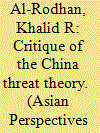

|
|
|
| 14 |
ID:
064094
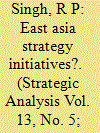

|
|
|
| 15 |
ID:
068059
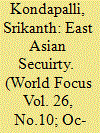

|
|
|
| 16 |
ID:
097028
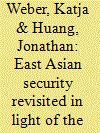

|
|
|
|
|
| Publication |
2010.
|
| Summary/Abstract |
This paper analyzes the relevance of the European integration experience for East Asia's future security architecture. Similar towhat happened in Europe, the paper argues, there may be a need for a cathartic process of remembrance and reconciliation in East Asia to help transcend historical legacies and create a solid foundation for integration. Considering the multi-faceted nature of security threats, moreover, it is hypothesized that the main ingredient of the European success strategy- the institutionalization of trust on multiple levels which, at least in some issue areas, requires the voluntary curtailment of states' autonomy- is likely to be emulated in the long run. A mini case study scrutinizes the essential elements of reconciliation (remembrance, restitution, apology) and shows how they enabled Germany to confront its past successfully, whereas Japanese attempts to transcend historical legacies thus far have fallen short. The paper then sketches several European institutional arrangements since the end of WorldWar II and, comparing them to East Asian security structures, speculates about future security provisions in East Asia.
|
|
|
|
|
|
|
|
|
|
|
|
|
|
|
|
| 17 |
ID:
094144
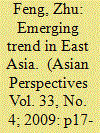

|
|
|
| 18 |
ID:
082252
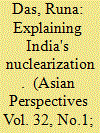

|
|
|
|
|
| Publication |
2008.
|
| Summary/Abstract |
This article presents an analytical hybrid of realism and critical social constructivism as its theoretical framework, and representations of (in)securities as an interpretation of politics, to explain India's nuclearization policies. Arguing that a linkage of political leaders' ideologies, articulation of statist identities, and (in)securities defines a state's security practices, I compare how the ideological perceptions of the postcolonial Indian state's leaders have articulated divergent notions of nationalisms, nationalist identities, and (in)securities and corresponding nuclear-policy choices. In charting this comparison, I explore how the political, economic, and developmental insecurities perceived by the Indian state under the Congress Party have become communal/cultural under the Bharatiya Janata Party, thereby facilitating the BJP's justification of India's nuclear-weapon tests. The article thus hopes to add to our understanding about the security problematiques of states and communities.
|
|
|
|
|
|
|
|
|
|
|
|
|
|
|
|
| 19 |
ID:
139157
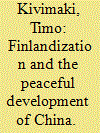

|
|
|
|
|
| Summary/Abstract |
The rise of China has brought about new considerations and a debate in East Asian security studies. Several of the countries neighbouring China have been probed for their degree of ‘Finlandization’, as manifest in excessive attentiveness to the interests of a neighbouring great power, due to the power asymmetry between the ‘Finlandized’ and the ‘Finlandizer’. This article will scrutinize Finlandization and determine to what extent the power relationship between Finland and the Soviet Union can be compared with the emerging power relationship that China’s East Asian neighbours will have to tackle. Furthermore, this article will seek from the Finnish experience lessons for East Asia on how to adapt to power realities without making the mistakes that Finland and the Soviet Union made in their relationship. China’s East Asian neighbours could learn how to avoid compromising their autonomy from Finland’s mistakes. They could also learn from Finnish realism how to tackle the security dilemma that the rise of Chinese power involves, and how to seek security in a way that would not make the rising great power feel any less secure.
|
|
|
|
|
|
|
|
|
|
|
|
|
|
|
|
| 20 |
ID:
112751
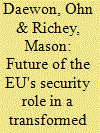

|
|
|
|
|
| Publication |
2012.
|
| Summary/Abstract |
A fundamentally new security landscape is unfolding in East Asia due to the
changing power structure among the great powers, particularly owing to the fast
rise of China and the relative decline of the United States. This paper analyzes the
dynamics of power transition in East Asia and assesses the possibility of the EU
playing a meaningful role in the strengthening of security governance in the
region. It begins by arguing that although the East Asian region is entering a
transformation stage it will not likely lead to a major collision between the United
States and China. This means the EU will have opportunities to become involved
in East Asian security affairs, provided it further strengthens its multi-faceted,
comprehensive engagement policies vis-à-vis the region. We focus particularly
on the EU's ability to promote the positive aspects of East Asian regionalism via
deepened and expanded cooperative measures such as bilateral and multilateral
framework agreements with regional countries and organizations. In addition to
offering a reliable model for regional security governance, the EU will be able to
contribute to regional security by cooperating with the United States and other
East Asian countries and organizations in selected security issues, such as sea-lane
protection, counter-terrorism, non-proliferation of Weapons of Mass Destruction
(WMD), humanitarian operations, etc. Internally, we show that after the Treaty of
Lisbon the EU is approaching incrementally a position wherein it can make
greater CFSP/CSDP engagements-particularly those associated with peacekeeping/
peacemaking and humanitarian operations-in the wider world including East
Asia.
|
|
|
|
|
|
|
|
|
|
|
|
|
|
|
|
|
|
|
|
|